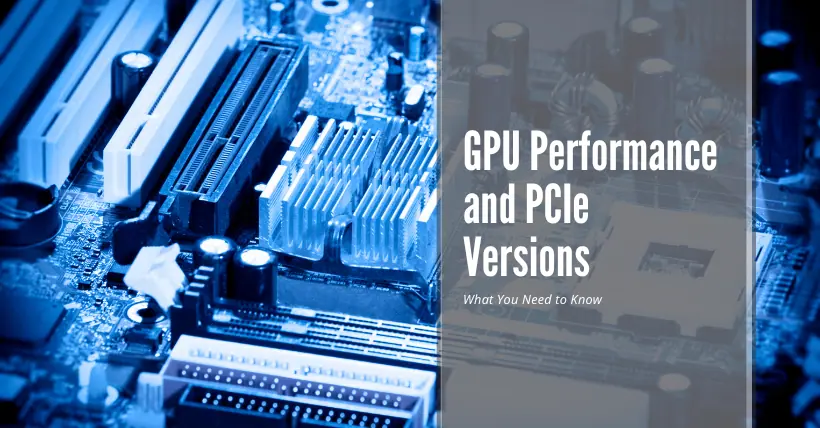Many people may not yet realize that PCIe 7.0 is on the horizon! In our current usage, PCIe 3.0 and PCIe 4.0 are the most common, with no signs of PCIe 5.0 becoming widespread, let alone the already released PCIe 6.0. It’s important to note that today’s discussion focuses on PCIe interfaces and versions, which differ from the PCIe standards for SSDs.
With PCIe 7.0 about to launch, some might worry that “old” PCIe 4.0 motherboards won’t keep up with the latest graphics cards. How significant is the impact of PCIe versions on graphics cards? Or are these concerns exaggerated?
1. PCIe is Forward and backward-compatible
Before delving into PCIe slots, it’s crucial to understand that PCIe slots have universal compatibility, similar to USB versions. As long as a device can physically fit into a PCIe slot, it will work.
PCIe retains the same physical design, so a PCIe 4.0 device can be inserted into a PCIe 3.0 slot, and vice versa. You can even place a PCIe 1.0 device into a PCIe 5.0 slot without any issues, provided the drivers work properly.
In graphics card specifications, almost all cards use the PCIe x16 slot, the longest slot, usually with a plastic locking clip on the right to secure the card. On most motherboards, this is the first slot from the top, while larger motherboards have multiple such slots.
The only difference between PCIe versions is the bandwidth speed per lane. Each generation roughly doubles the maximum transfer rate: PCIe 1.0 supports 0.250GB/s per lane, PCIe 2.0 supports 0.500GB/s per lane, and so on. The upcoming PCIe 7.0 will support up to 15.125GB/s per lane in a single-lane configuration, approaching the bandwidth of a PCIe 3.0 x16 slot.
While PCIe slots are backward compatible, to fully utilize higher transfer rates, both the PCIe slot and the graphics card must support the latest version. In a PCIe 3.0 slot, the speed of a PCIe 4.0 graphics card will be limited to PCIe 3.0 speeds.
2. PCIe Lane Count Also Matters
PCIe lanes are the channels that allow data transfer between the motherboard and the graphics card. The lane count is indicated by a lowercase “x” followed by a number, such as PCIe x16 for 16 lanes and PCIe x2 for two lanes.
Interestingly, graphics cards have long used PCIe x16, but with the release of PCIe 4.0, some cards have been reduced to x8 or even x4 lanes. Since a PCIe x8 4.0 slot supports the same maximum transfer rate as the previous generation’s PCIe x16 3.0 slot, NVIDIA and AMD opted to cut down to 8 lanes on some budget options to save costs.
The issue arises when a PCIe x8 4.0 card is installed in a PCIe x16 3.0 slot, resulting in half the maximum bandwidth, as the speed will be limited to PCIe x8 3.0. In theory, this could negatively impact performance.
The good news is that this performance impact is mostly negligible because graphics cards use less bandwidth than you might think. For example, a PCIe x8 4.0 RX 6600 XT installed in an older motherboard with a PCIe x16 3.0 slot shows almost no noticeable performance issues. Tests with high-end RTX 4090 cards in PCIe 3.0, 4.0, and 5.0 slots revealed performance differences of only 1-3% in most games.
Therefore, while PCIe versions should be noted, they are not decisive factors. You can mix and match graphics cards and motherboards freely. The only noteworthy exceptions are PCIe x4 cards, like the RX 6400 and RX 6500 XT. These cards use only four PCIe 4.0 lanes, which means significant performance issues in PCIe 3.0 slots.
3. PCIe Versions Primarily Impact High-Bandwidth SSDs
When even the highest-end graphics cards are barely affected by PCIe versions, many might wonder why manufacturers have been pushing for newer versions in recent years. The answer lies in high-bandwidth NVMe SSDs. High-end SSDs can utilize PCIe 4.0 and 5.0 to achieve extremely high transfer speeds.
However, unless frequently transferring files between SSDs, many people don’t need PCIe 5.0 SSDs. For gamers, even a PCIe 3.0 NVMe SSD is sufficient to meet their needs.
Related:
- PCIe Hot Plug Explained Clearly in One Expert Guide
- PCIe 7.0 Final Draft Is Out—SSDs Must Wait 3 Years
- RTX 5090 Benchmark: PCIe 5.0 vs 4.0 Gaming Comparison
- PCIe 6.0 for AI and Data Centers, PCIe 7.0 on Horizon
- PCIe 6.0 SSD Controllers in Development by Silicon Motion
- Samsung Launches MP9E1 SSD: 14.5GB/s Performance
- PCIe 7.0 Optical Boosts to 512GB/s Bandwidth
- First Raspberry Pi SSD: Compact M.2 2230, PCIe 3.0 Ready
- SanDisk Launches PCIe 5.0 SSD: Just 7W Power Consumption

Disclaimer: This article is created by the original author. The content of the article represents their personal opinions. Our reposting is for sharing and discussion purposes only and does not imply our endorsement or agreement. If you have any objections, please get in touch with us through the provided channels.



